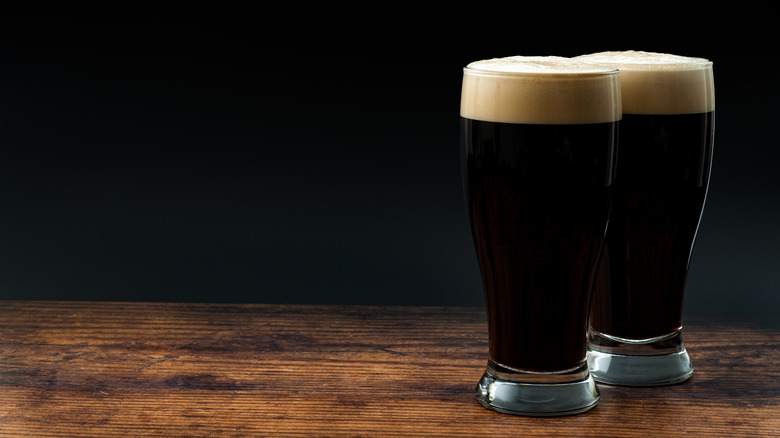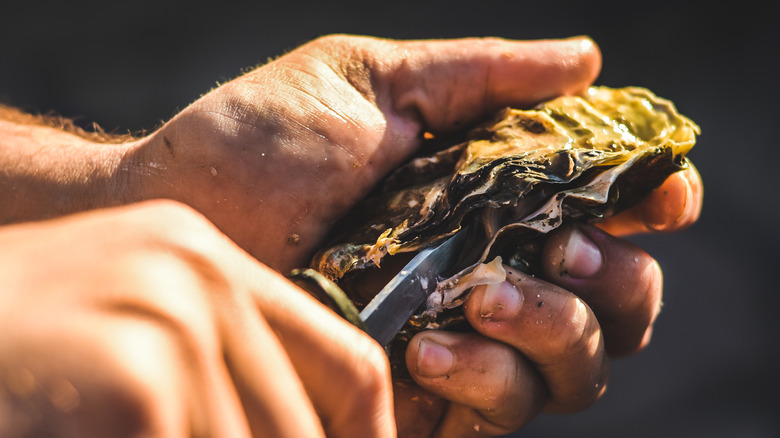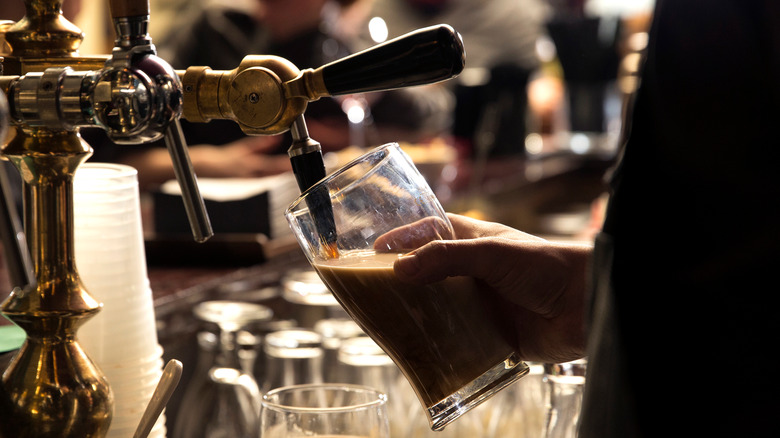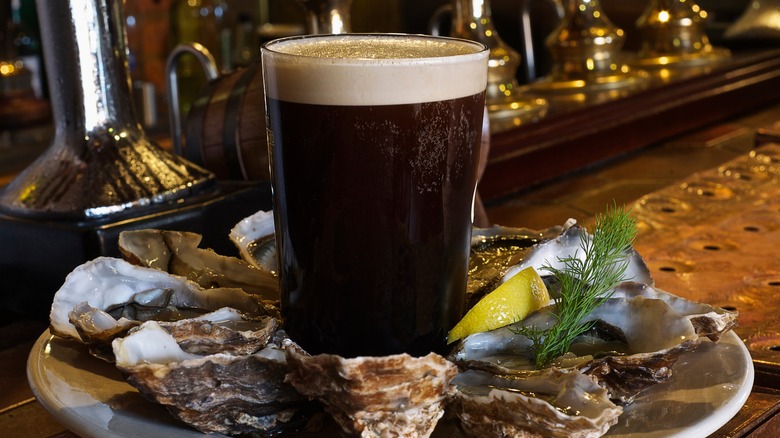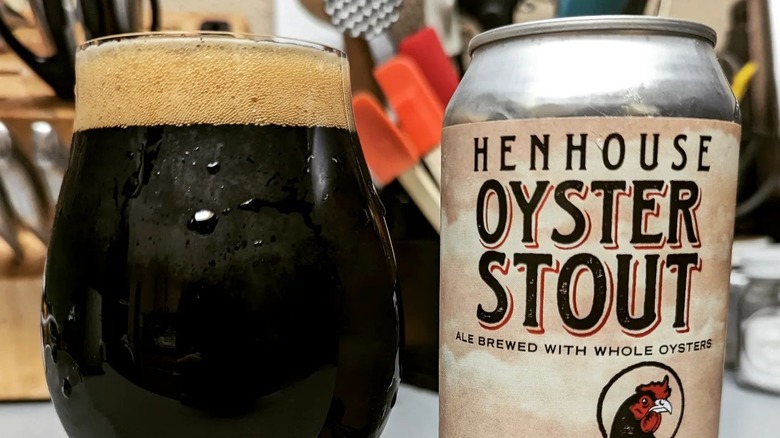Are Oyster Stouts Actually Made With Oysters?
The craft beer industry is one that continues to evolve and grow, pushing the envelope even further. With the popularity they've amassed over time, craft breweries seem to be concocting what they like to call culinary beers. You'll find no shortage of beers brewed with wild ingredients like edible glitter, Krispy Kreme donuts, whale testicles, and lobster.
While this aquamarine-style brewing may seem far-fetched, history tells a different story. In centuries past, shellfish were not nearly the luxuries they are in modern times. Mollusks and shellfish were dirt cheap and routinely used to feed prisoners, slaves, and servants in Colonial America. Oysters, in particular, were immensely popular and affordable throughout the 18th, 19th, and early 20th centuries.
Across the pond in the United Kingdom and Ireland, oysters are routinely paired with stouts — the preferred beer style. However well the two paired together, no one remotely thought of combining the two. That is, until 1929 in New Zealand when someone decided to develop a wort of stout boil and oyster meat. And thus, oyster stout was born.
While this may sound like a strange combination of ingredients on paper, there is actually a historical degree of use when it comes to oysters and beer. Owing to their naturally high calcium content, oysters were first used in brewing as filtering agents.
Oysters were once used to filter stouts and are a primary ingredient
Long before anyone actually plopped oysters into a boiling brew, they were being used to refine and clarify beer. While beer itself was not yet being brewed with oysters, their shells were often used as a filtration method for refining and clarifying not just stouts but other alcohols as well.
When we consider that, in its natural habitat, an oyster filters water by absorbing excess nitrogen into their shells, we can put two-and-two together and see just how brilliant 19th century brewers were. Oyster shells were in excess owing to their popularity, so why not use them?
For the modern-day brewery, most beers are filtered using a mechanically rotating centrifuge that separates yeast and protein particles from the beer. Owing to this available technology, brewers no longer use oysters as a mere filtering tool but use them as a critical ingredient in the brewing of stouts.
Oyster stouts are top-fermented with whole oysters or just the shell
There are a lot of different elements that come into play when brewing a stout, one of which is the all-important fermentation. Stout is top-fermented, meaning that the yeast floats to the top of the beer during fermenting instead of sinking to the bottom, as would occur with a lighter beer such as lager. The presence of the floating yeast is also why filtration is important.
Stouts generally tend to be viewed as heavy drinks. While there certainly is some truth to this, it is hardly indicative of the entire segment. Some stouts can be exceptionally light and dry, which serve as the perfect base for adding oysters.
There are two ways oysters can be used when it comes to brewing stout: whole and shell. For heavier stouts, like oatmeal or an Imperial, whole oysters are used to maximize their briny flavor. For light, dry stouts, the shells are just used as the flavor is intended to be more of a whisper than a shout.
Added early during the boiling period to extract as much of their flavor as possible, the oysters impart their savory notes to the stout. The added salt complements the bitter and slightly sweet elements these dark beers are known for.
What do oyster stouts taste like?
While the oysters are said to impart some of their fresh oceanic flavor to the stout, the amount varies depending on how much of the mollusk is used. The shells will impart less flavor than the whole, intact oyster will. If anything, oyster stouts have been described as mildly briny with a hint of calcium, much like an oyster itself.
In some cases, brewers have had to add flakes of sea salt to amplify the ocean flavor they strive for. The important thing to remember is that the stout flavors come first. You're drinking experience is not intended to be akin to consuming a liquified oyster.
In order to understand the types of flavors the oyster is competing with, it's important to contrast heavy and light stouts. Imperial stouts perhaps offer the best contrast to a dry oyster stout, as they are strong and rich with deep flavors of roasted barley, hops, and alcohol.
Contrasted with Guinness, a traditional dry stout, it has a far subtler roasted flavor that is much heavier on bitterness. Imperial stouts pair very well with desserts, while a dry stout is better for enjoying along with a meal. This is why most oyster stouts tend to begin with this dry base, for more often than not, their intended purpose is for subtlety.
Oyster stouts pair well with oysters
It should be no surprise to discover that oyster stout pairs well with, wait for it – oysters. Shocking, right? When it comes to oyster stouts, you really don't need to think too hard about what to pair it with. Oysters are, by their presence in the beer itself, great to pair with a stout. However, this needn't be exclusive.
You could also try it out with other shellfish, as well as a tangy cheese, stew of red meat, or decadent chocolate dessert, all of which classically pair well with stout. The salt imparted by the oysters in the stout could help elevate the sweetness of a dessert or enhance the savoriness of another meat. And when paired with oysters, the oysters just taste better.
Oysters and stout have a long history together. Over in Ireland, when oysters were readily available and affordable for working-class Irish families, a cheap plate of oysters and a pint of Guinness made for an excellent small meal. Guinness's rich, creamy, mineral flavor offers a refreshing and complementary companion to the salty oysters.
The oysters' brine also helps draw out the more complex undertones of the Guinness itself. Naturally, when combining these two bosom friends into one beer, the minerals and the tartness of the stout mixed with the brine of the oysters can only serve to amplify flavor even further.
Oyster stout brands to consider
The oyster stout has a decent amount of representation in the U.S. beer market, with several brewers nationwide hopping on board this oyster stout train. Indeed, this little stout has gone from relative obscurity to a well-established brewing style.
California has good representation in the oyster stout market, with breweries like HenHouse Brewing Co. out of Petaluma offering a few different options. They have their classic Oyster Stout, which uses whole oysters from Hog Island Oyster Co. and a dash of sea salt to really up the seafaring theme of the beer. Another oyster offering is the Umbo Fantasmo, a barrel-aged, jet-black stout brewed with specialty malts and whole oysters. The resulting brew has a deep aroma and a spicy, earthy taste, thanks in part to the red wine barrel it is aged in.
Other oyster stout breweries include Great Lakes Brewing Co., which offers an Imperial stout brewed with East Coast oysters, and Oxbow Brewing, where you can try a dark farmhouse ale brewed with jumbo oysters from midcoast Maine's Damariscotta River. White Stone Oyster Co. recommends Oysterhouse Brewing Company out of Asheville, North Carolina, for their low ABV, refreshing oyster stout that utilizes the whole mollusk.
